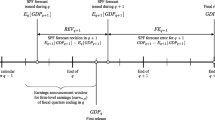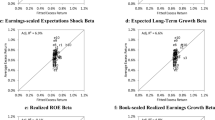Abstract
We develop and test explanations for sources of intertemporal variation in the information content of aggregate earnings and how that variation explains variation in the relation between aggregate earnings growth and market returns over time. We find that the correlation between aggregate earnings growth and leading market-wide real output shocks (measured by the growth in the Federal Reserve Board’s index of industrial production) becomes more pronounced in the 1990s and 2000s, which explains why the aggregate earnings-return relation is significantly positive in this period. Further analysis shows that an increasingly positive relation between aggregate earnings growth and real output shocks is attributable to the changing nature of the economic activity in the United States, namely, a shift in the composition of firms toward financial services and away from manufacturing. Changes in accounting measurement rules over time to include more fair value estimates also play a role in explaining why the aggregate earnings–return relation has become significantly positive in recent decades.


Similar content being viewed by others
Notes
Additional evidence supporting our inferences about the drivers of the sign of the AE-AR relation over time is that we find no evidence of a positive relation between AE growth and leading real output growth before 1974.
All results reported in the paper are robust to excluding the 2007–2009 financial crisis.
In untabulated tests (available upon request), we find similar evidence of a stable positive relation between ARq and alternative measures of real output growth, namely, the quarterly growth in The Conference Board’s coincident economic index (CEIG).
Results of estimating Eq. (2b) for ΔAE as the response variable are untabulated (available upon request).
Evidence in model (4) also suggests that pre-1974 periods are characterized by a negative relation between real output shocks and ΔAEq-1 when using CEIG as the measure of real output.
An alternative explanation is that innovations in AE growth reflect time-varying risk premium news in recent periods, which in turn affects real output growth via shifts in investment. We address this concern in later tests by including proxies for discount rate shocks when estimating the AE-AR relation.
We verified that the estimates for the models in Panel B of Table 4 are not affected by multi-collinearity, as the variance inflation factors are below 3 (where the common cutoff is 10).
Untabulated results (available upon request) based on estimating the models in Table 5, Panel B, using the “news” in sector-level earnings (estimated using an AR[1] model similar to that discussed earlier in the text for ΔAE) in place of the unadjusted sector-level earnings growth measures show that the nonmanufacturing industrial sector (ΔAE_NONMFG_NEWS) contains significant cash flow news, as evidenced by a positive coefficient from 1995 to 2015 in the re-estimated versions of models (4) (p value <0.10) and (5) (p value <0.05). We also find that, while the innovation in sector-level earnings for financial firms (ΔAE_FI_NEWS) continues to display a significant positive association with announcement-quarter market returns in model (4) (p value <0.05), this relation is insignificant after controlling for ΔDEFq + 1 in model (5). One interpretation of the weaker relation between ΔAE_FI_NEWS and ARq + 1 (vis-à-vis our main analysis) is that real output news in financial sector earnings growth is driven by its correlation with announcement-quarter shifts in the risk premium that affect investment and thereby real output.
We also observe a similar pattern for the persistence of CEIG across these subperiods as an alternative measure of real output growth (untabulated for brevity).
We elected to sort firms using the magnitude of non-operating income to capture both routine and nonroutine fair value adjustments and to ensure consistent coverage in the quarterly Compustat database. An alternative to measure the fair value adjustments below operating income would be to use the magnitude of special items in the quarterly database. We opted not to do that due to limited coverage of special items prior to 1982 and in periods other than the fourth quarter. See Burgstahler, Jiambalvo, and Shevlin (2002, p.592), who state: “While the back data files contain data as early as 1965, our analysis begins with 1982 because … there is a substantial increase in the number of firms for which Compustat shows nonzero special items beginning in 1982.”
As an alternative to tests based on NOI-ranked portfolio earnings, in untabulated tests (available upon request), we re-estimated Eq. (5b) for announcement-quarter market returns, where we included innovations in both aggregate earnings (ΔAE_NEWS) and aggregate operating income after depreciation (OIADP in Compustat) each estimated from separate rolling AR(1) models. The results of these tests show that innovations in aggregate operating income display no incremental explanatory power for ARq + 1. Because operating income excludes fair value adjustments, such as goodwill impairments and holding gains and losses on financial assets, these results further support our inference that fair value adjustments in non-operating income are important for explaining the pricing of AE growth in the 1995–2015 period.
A final result in Panel B worth noting is that coefficients on ΔAE_LowNOIq are negative and significant across models (1)–(6). This suggests that aggregate operating income growth primarily reflects information about discount rates (e.g., Shivakumar and Urcan 2017; Gallo et al. 2016), expected returns (e.g., Sadka and Sadka 2009; Bailey and Lai 2019), or both.
References
Adrian, T., Moench, E., & Shin, H. (2010). Financial intermediation, asset prices and macroeconomic dynamics. In SSRN scholarly paper ID 1532319. Rochester: Social Science Research Network.
Bailey, W., and H. Lai. 2019. On the expected earnings hypothesis explanation of the aggregate returns-earnings association puzzle. Journal of Financial and Quantitative Analysis, forthcoming.
Ball, R., & Sadka, G. (2015). Aggregate earnings and why they matter. Journal of Accounting Literature, 34, 39–57.
Burgstahler, D., Jiambalvo, J., & Shevlin, T. (2002). Do Stock prices fully reflect the implications of special items for future earnings? Journal of Accounting Research, 40(3), 585–612.
Campbell, J. Y. (1991). A variance decomposition for Stock returns. The Economic Journal, 101(405), 157–179.
Campbell, J. Y., & Shiller, R. J. (1988). Stock prices, earnings, and expected dividends. The Journal of Finance, 43(3), 661–676.
Choi, J. H., Kalay, A., & Sadka, G. (2016). Earnings news, expected earnings, and aggregate Stock returns. Journal of Financial Markets, 29, 110–143.
Cochrane, J. H. 2009. Asset pricing: Revised Edition. Princeton, NJ: Princeton University Press.
Cready, W., & Gurun, U. (2010). Aggregate market reaction to earnings announcements. Journal of Accounting Research, 48(2), 289–334.
Fama, E. F. (1981). Stock returns, real activity, inflation, and money. The American Economic Review, 71(4), 545–565.
Fama, E. F. (1990). Stock returns, expected returns, and real activity. The Journal of Finance, 45(4), 1089–1108.
Fama, E. F., & French, K. R. (1988). Dividend yields and expected Stock returns. Journal of Financial Economics, 22(1), 3–25.
Fama, E. F., & French, K. R. (1989). Business conditions and expected returns on stocks and bonds. Journal of Financial Economics, 25(1), 23–49.
Feldstein, M. S. (2017). Underestimating the real growth of GDP, personal income and productivity. Journal of Economic Perspectives, 31(2), 145–164.
Gallo, L. A., Hann, R. N., & Li, C. (2016). Aggregate earnings surprises, monetary policy, and Stock returns. Journal of Accounting and Economics, 62(1), 103–120.
Hann, R. N., Li, C., & Ogneva, M. (2017). Another look at the macroeconomic information content of aggregate earnings: Evidence from the labor market. In SSRN scholarly paper ID 2993654. Rochester: Social Science Research Network.
He, W., & Hu, M. R. (2014). Aggregate earnings and market returns: International evidence. Journal of Financial and Quantitative Analysis, 49(04), 879–901.
Kaul, G. (1987). Stock returns and inflation: The role of the monetary sector. Journal of Financial Economics, 18(2), 253–276.
Khan, U., & Ozel, N. B. (2016). Real activity forecasts using loan portfolio information. Journal of Accounting Research, 54(3), 895–937.
Konchitchki, Y., & Patatoukas, P. N. (2014). Taking the pulse of the real economy using financial statement analysis: Implications for macro forecasting and Stock valuation. The Accounting Review, 89(2), 669–694.
Kothari, S. P. (2001). Capital markets research in accounting. Journal of Accounting and Economics, 31(1), 105–231.
Kothari, S. P., Lewellen, J., & Warner, J. B. (2006). Stock returns, aggregate earnings surprises, and behavioral finance. Journal of Financial Economics, 79(3), 537–568.
Kothari, S. P., & Shanken, J. (1992). Stock return variation and expected dividends: A time-series and cross-sectional analysis. Journal of Financial Economics, 31(2), 177–210.
Lahiri, K., & Monokroussos, G. (2013). Nowcasting US GDP: The role of ISM business surveys. International Journal of Forecasting, 29(4), 644–658.
McQueen, G., & Roley, V. V. (1993). Stock prices, news, and business conditions. The Review of Financial Studies, 6(3), 683–707.
Newey, W. K., & West, K. D. (1987). A simple, positive semi-definite, Heteroskedasticity and autocorrelation consistent covariance matrix. Econometrica, 55(3), 703–708.
Sadka, G. (2007). Understanding Stock Price volatility: The role of earnings. Journal of Accounting Research, 45(1), 199–228.
Sadka, G., & Sadka, R. (2009). Predictability and the earnings-returns relation. Journal of Financial Economics, 94(1), 87–106.
Schwert, G. W. (1990). Stock Returns and Real Activity: A Century of Evidence. The Journal of Finance, 45(4), 1237–1257.
Shah, H. C. (1990). Stock returns and anticipated aggregate real activity. Graduate School of Business: University of Chicago.
Shivakumar, L. 2007. Aggregate Earnings, Stock Market Returns and Macroeconomic Activity: A Discussion of ‘Does Earnings Guidance Affect Market Returns? The Nature and Information Content of Aggregate Earnings Guidance.’ Journal of Accounting & Economics 44 (1/2): 64–73.
Shivakumar, L., & Urcan, O. (2017). Why does aggregate earnings growth reflect information about future inflation? The Accounting Review, 92(6), 247–276.
Stock, J. H., & Watson, M. W. (1989). New indexes of coincident and leading economic indicators. NBER Macroeconomics Annual, 4, 351–394.
The Conference Board. 2001. Business cycle indicators handbook. The Conference Board, Inc.
White, H. 1980. A Heteroskedasticity-consistent covariance matrix estimator and a direct test for Heteroskedasticity. Econometrica: Journal of the Econometric Society, 817–838.
Zolotoy, L., Frederickson, J. R., & Lyon, J. D. (2017). Aggregate earnings and Stock market returns: The good, the bad, and the state-dependent. Journal of Banking & Finance, 77, 157–175.
Acknowledgements
We benefitted from comments and suggestions by two anonymous reviewers and from Michelle Hanlon, SP Kothari, Craig Nichols, Stephen Penman (editor), Jerry Warner, Joanna Wu, Jerry Zimmerman, workshop participants at Syracuse University and the University of Rochester, and especially Bill Schwert. We acknowledge a senior corporate profits analyst at the U.S. Bureau of Economic Analysis (BEA) for answering questions about BEA data. We acknowledge financial support provided by the Simon School at the University of Rochester.
Author information
Authors and Affiliations
Corresponding author
Additional information
Publisher’s note
Springer Nature remains neutral with regard to jurisdictional claims in published maps and institutional affiliations.
Appendix A
Appendix A
Rights and permissions
About this article
Cite this article
Kim, J., Schonberger, B., Wasley, C. et al. Intertemporal variation in the information content of aggregate earnings and its effect on the aggregate earnings-return relation. Rev Account Stud 25, 1410–1443 (2020). https://doi.org/10.1007/s11142-020-09538-9
Published:
Issue Date:
DOI: https://doi.org/10.1007/s11142-020-09538-9
Keywords
- Aggregate earnings
- Aggregate earnings-return relation
- Market returns
- Real output
- Industrial production growth
- Financial sector
- Fair value accounting




